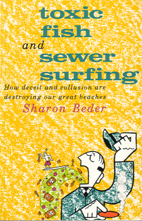
by Sharon Beder
first published by Allen & Unwin, Sydney, 1989
Introduction
Sewers seaward
Toothless watchdog
Toxic fish
Sewer-side surfing
Public relations battle
Events of 1989
Beyond Sydney
Conclusion
Bibliography
At Coffs Harbour an ocean outfall is to be built at Look-At-Me-Now headland near Emerald Beach. It is an area with a unique ocean ecology, a result of the meeting of tropical and temperate marine life. The sewage outfall will discharge into the midst of a proposed marine park to protect the area. It will be within sewage-travelling distance of three islands considered to have ecosystems of special value. Both the New South Wales Department of Agriculture and the National Parks and Wildlife Service have expressed grave reservations about the outfall.
Moreover, the people of Coffs Harbour are opposed to ocean outfalls. A 1982 proposal for an outfall at Moonee headland was discarded because of public opposition. However, the need for some sort of plan for dealing with sewage grew along with rapid development in this popular and beautiful area. When it was proposed in l985 that an outfall be sited at Woolgoolga headland to dispose of secondary treated effluent from a number of villages and developments north of Coffs Harbour, 4000 people marched in protest. (The population of the Northern Beaches area is about 8500.)
A Commission of Enquiry was appointed to review the options. It reported in mid-1987 that there were no alternatives to an ocean outfall in the short term and recommended that the outfall be built not at the Woolgoolga headland but at the Look-At-Me-Now headland, where fewer people lived and where it was thought less damage would be done to the coral reefs. Alternatives to ocean outfalls put forward by locals, such as reusing the effluent on golf courses, forests, banana plantations and as ‘greywater’ (water for purposes other than drinking or cooking) in towns were dismissed because of the volume of sewage involved and the cost and time necessary to develop such options. The Commissioner suggested, however, that they be followed up for future consideration.
Council elections had been held in the meantime, and although several councillors who had campaigned on a ticket of ‘no ocean outfall’ were elected, the council voted 5 to 4 to implement the Commission’s proposals. The Mayor, who had previously marched against the Woolgoolga outfall, voted in favour of the scheme as well as another ‘no ocean outfall’ alderman, who claimed he had been convinced by Council engineers. This led some voters to feel they had been betrayed. Emerald Beach people formed a group called Stop The Outfall Pollution (STOP) to fight the proposal. Their case was strengthened immensely when at the end of 1988 the New South Wales Government proposed a Marine National Park in the area. However, it has now been decided that an Aquatic Reserve will be established instead, at least in the short-term. An aquatic reserve does not offer the same protection as a Marine National Park and will allow the outfall to go ahead as well as an outfall for a proposed pulp mill to be sited at Grafton.
The Coffs Harbour controversy is interesting because it is one of the few places where engineers are on both sides of the debate. A group of engineers called ‘Engineers Against Outfalls’ has been formed. They argue that the wider Coffs Harbour area is unique in that it has so many sites for effluent reuse. They have also tried to point out the way the Council and the PWD engineers have exaggerated the predicted performance of the plant and outfall and generally attempted to mislead the public into believing that the proposed scheme would have no adverse environmental impact.
One of the more vocal engineers in this group, John Tozer, has been the target of attack by council engineers. Six engineers employed by Coffs Harbour City Council have lodged a formal complaint against Tozer for breaching engineering ethics. They argue that he has harmed their reputation with their employers by criticising the advice they have given council; that he has made statements that were not based on adequate knowledge, notably his claims that there were viable alternatives to ocean outfalls; that he has not upheld and enhanced the honour and integrity of the engineering profession because of criticism of them in a private letter sent to them; and that he has not put the interests of the public first because he did not put in a submission on the Environmental Impact Statement for the Woolgoolga outfall or to the Commission of Inquiry.
Such accusations would be laughable if they were not a blatant attempt to use the code of ethics to silence a critic. One council engineer even drew up a media release to be signed by Tozer and offered to withdraw the complaints and not to proceed with lawsuits if Tozer agreed to send his retraction out to the media. Tozer has said in his own defence:
One of the driving influences towards my involvement in this debate has been the public dismay at the Council and PWD engineers’ lack of ability to solve the problem without an Ocean Outfall and the public’s perception that was developing of the Engineering profession, of being incapable of responding to the community’s needs. I felt compelled not only with respeçt to my duty to the community to inform the public that there were Engineers who believed the problem was solvable but also to protect what I felt was the public’s resentment and disillusionment towards our profession. . .
Tozer claims that he has had private support from a wide range of engineers, including PWD engineers, and council staff, many of whom are unable to speak out publicly because of their jobs. In the meantime the sewage scheme he objected to is going ahead.